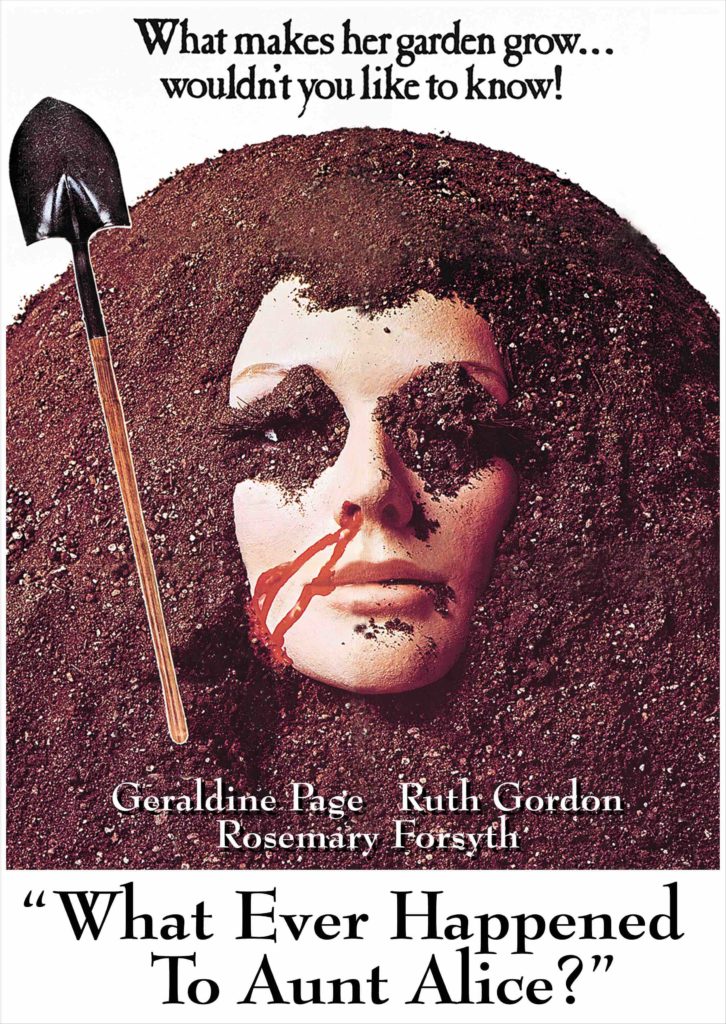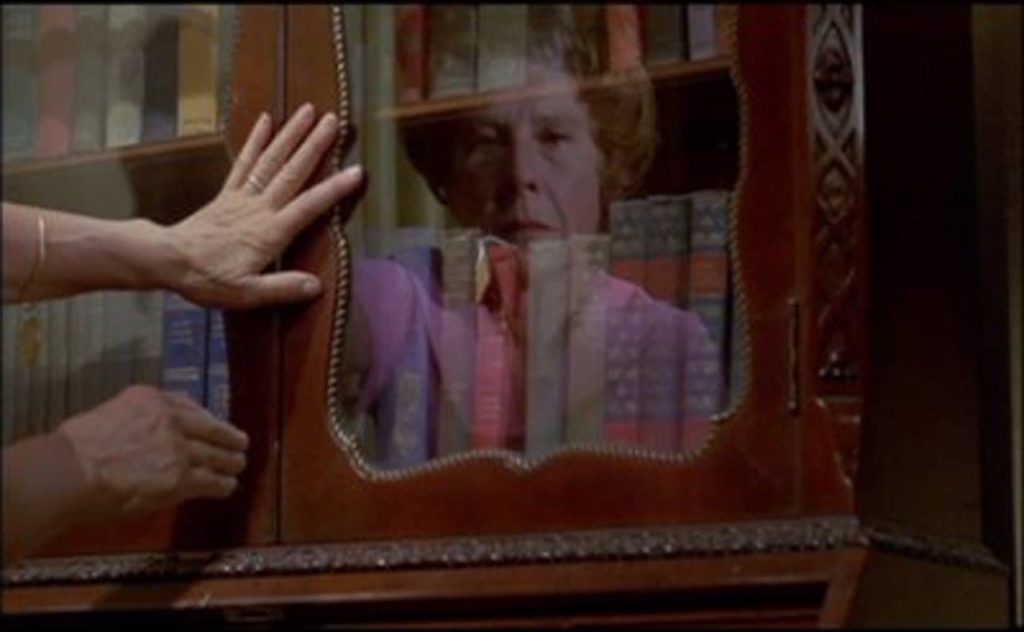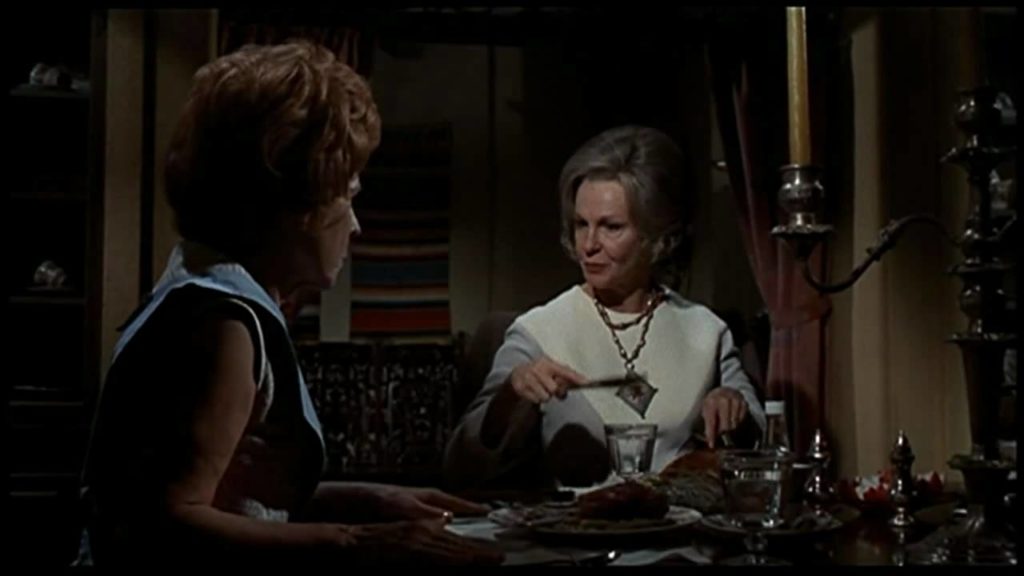Geraldine Page And Ruth Gordon Gamely Answer Gleefully Ghoulish Title Question

DIRECTED BY LEE H. KATZIN (Uncredited: BERNARD GIRARD)
STREET DATE: January 8, 2019/KINO LORBER STUDIO CLASSICS
Kino Lorber’s follow-up to two bookending independent productions from producer/director Robert Aldrich released on Blu-ray last November, including 1968’s The Killing of Sister George and 1971’s The Grissom Gang, ushers in the new year with the sole Associates & Aldrich film the daring auteur did not direct but only produced. From the title and premise to its key artistic personnel, however, Robert Aldrich’s signature and sensibility is nevertheless writ large on 1969’s What Ever Happened to Aunt Alice? Purposely echoing the title of Aldrich’s wildly influential masterwork What Ever Happened to Baby Jane? (1969), in addition to the similar pairings of mature(r) actresses in Hush… Hush Sweet Charlotte (1964) and his later Sister George, even the look of the film, courtesy of Aldrich’s frequent cameraman Joseph Biroc, retains visual and atmospheric continuity from the producer’s previous Grand Dame Grand Guignols.

Geraldine Page and Ruth Gordon step into what was an already established genre of Aging Female Gothic — if Billy Wilder’s 1950 Sunset BLVD provided the template, Baby Jane, Strait-Jacket (1964), The Nanny (1965) etc. proved its unintentionally appropriate longevity — to provide their own unique dynamic of murder and mayhem most un-demure. Adapted from Ursula Curtiss’s 1962 thriller The Forbidden Garden, the re-titled title poses a question no character in the film would ask until two-thirds of the way through, and then only by whom we learn is the title character’s nephew (played by Robert Fuller; who would be unlikely to ask it at that point in the story, anyway), but that inconsistency — part and parcel with a film began by one director (an uncredited Bernard Girard), finished by another (the credited Lee H. Katzin), yet seeming somehow to belong artistically to its producer (the under-credited Robert Aldrich) — actually adds to the compelling yet mystifying layers of this film-length puzzlement. Much of the pleasure of these films comes from polite social conventions being upset and, indeed, upended by bitter rivalry — profaning everything from, famously, dinner poorly-served to, here, lifestyles ill-maintained — and What Ever Happened to Aunt Alice? rarely disappoints despite or even due to the jarring juxtapositions of character motives and their unexpected outcomes.
Mrs. Marrable, recently widowed and suddenly broke in the film’s pre-credits prologue, moves Southeast to remote desert Arizona, where her money-making scheme involves employing a succession of lonely housekeepers, robbing them of their life-savings, and planting another in a growing line of pine trees on her property, whose individual roots both conceal and feed off the murdered, buried corpses of the predatory mistress’s former companions. Mrs. Dimmock is Mrs. Marrable’s latest servant-victim, who provides her vampiric employer with the first shades of suspicion that someone may be on to her gruesome game. Echoing the question of the title, as the film descends through ever-spiraling layers of untoward social transgressions, will Mrs. Marrable plant yet another pine tree?
As it turns out, not quite, but even Mrs. Marrable’s story-ordained downfall, and title-telegraphed fate of her last victim, Mrs. Dimmock, barely conceals the growing tendrils of deceit, jealousy, and suspicion poking provocatively from the hot, desert sand. At the age of 44 during production, Geraldine Page imbues Mrs. Marrable with an unconcealed fury that makes both stinging social slights — her selfishly satisfied, solitary drink in one mid-film scene is a highlight — and brutal cold-cocks into open graves equally terrifying. Matching that wounded psychosis with cool equanimity, Ruth Gordon — nearly three decades older — plays her far from passive victim Mrs. Dimmock AKA Aunt Alice with a knowing and subtly manipulative staying power; holding her own despite, say, the mid-film humiliation of pouring her unshared end of that drink back into that bottle (even dutifully wiping down same to avoid, in Mrs. Marrable’s words, a despised “sticky brandy bottle”).

The dynamic between gardener and potentially gardened, one more soon-to-be one-time companion who has outlived her former financial advantage, and who may or may not be murderously transformed into landscape, gifts the gynocidal goings-on that more than answered this audience of one’s possible objections to plot confusion, inconsistent (and worse, uninteresting) supporting characters, and a sometimes experimentally effective though more often distractingly on-the-nose score from Gerald Fried. What Ever Happened to Aunt Alice?, despite, again, or even because of the complications of its production, succeeds in character denoting its multiple levels of toxic desperation due to the unyielding screen strength of its female star combatants.
Remastered in a new 4K scan, Kino Lorber’s Blu-ray reproduces the bold visuals of its source material in a crisp level of detail that may have appeared alternately muted or garish in previous home video releases. Besides its artful angles, horror film-like close-ups, and moody lighting scheme, the atmosphere similarly provided by two characters malevolently addressing each other through gritted teeth by the honorarium “Mrs.” can be finally appreciated for its darker as opposed to simply murky pleasures. Richard Harland Smith once again outdoes himself with a great commentary, informative and scholarly as it is witty and fun. Like this viewer, one may miss who precisely was Aunt Alice on a first viewing, and remain puzzled over what happened to her on a second — expecting if not a miraculous third-act re-emergence, then at least a bodily resurfacing — but fortunately Mrs. Marrable offers something of a satisfying memoriam for them both in the film’s closing moments. For women of a certain age, as the saying then went, perhaps that is enough.
Images used in this review are only a visual reference to the film and are not meant to reflect the image quality of Kino Lorber’s Blu-ray release.

